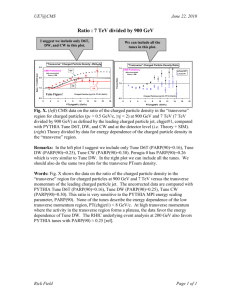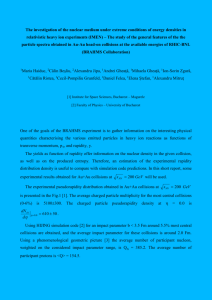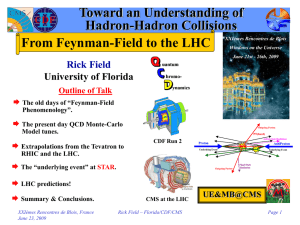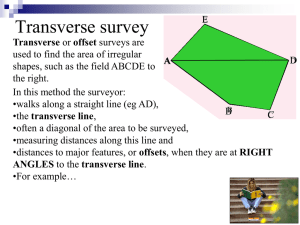RHIC & AGS Annual Users’ Meeting “Min-Bias” and the “Underlying Event”
advertisement
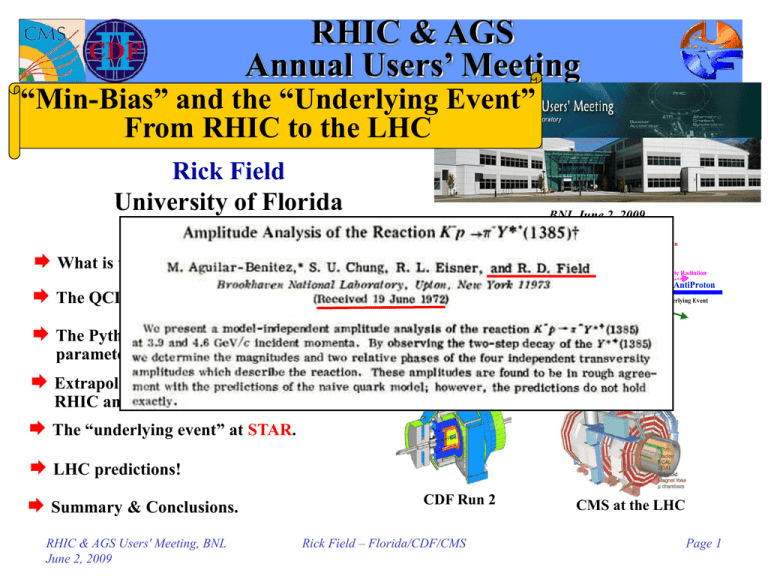
RHIC & AGS Annual Users’ Meeting “Min-Bias” and the “Underlying Event” From RHIC to the LHC Rick Field University of Florida BNL June 2, 2009 Outline of Talk Outgoing Parton What is the “underlying event”? PT(hard) Initial-State Radiation Proton The QCD Monte-Carlo Model tunes. AntiProton Underlying Event The Pythia MPI energy scaling Outgoing Parton parameter PARP(90). Underlying Event Final-State Radiation Extrapolations from the Tevatron to RHIC and the LHC. The “underlying event” at STAR. LHC predictions! Summary & Conclusions. RHIC & AGS Users' Meeting, BNL June 2, 2009 CDF Run 2 Rick Field – Florida/CDF/CMS CMS at the LHC Page 1 QCD Monte-Carlo Models: High Transverse Momentum Jets Hard Scattering Initial-State Radiation Hard Scattering “Jet” Initial-State Radiation “Jet” Outgoing Parton PT(hard) Outgoing Parton PT(hard) Proton “Hard Scattering” Component AntiProton Final-State Radiation Outgoing Parton Underlying Event Underlying Event Proton “Jet” Final-State Radiation AntiProton Underlying Event Outgoing Parton Underlying Event “Underlying Event” Start with the perturbative 2-to-2 (or sometimes 2-to-3) parton-parton scattering and add initial and finalstate gluon radiation (in the leading log approximation or modified leading log approximation). The “underlying event” consists of the “beam-beam remnants” and from particles arising from soft or semi-soft multiple parton interactions (MPI). The “underlying event” is“jet” an unavoidable Of course the outgoing colored partons fragment into hadron and inevitably “underlying event” background to most collider observables observables receive contributions from initial and final-state radiation. and having good understand of it leads to more precise collider measurements! RHIC & AGS Users' Meeting, BNL June 2, 2009 Rick Field – Florida/CDF/CMS Page 2 QCD Monte-Carlo Models: Lepton-Pair Production Lepton-Pair Production High PT Z-Boson Production Anti-Lepton Outgoing Parton Initial-State Initial-State Radiation Radiation High P T Z-Boson Production Lepton-Pair Production Initial-State Initial-StateRadiation Radiation “Jet” Proton Proton Final-State Radiation Outgoing Parton Anti-Lepton Final-State Radiation “Hard Scattering” Component AntiProton AntiProton Underlying Event Lepton Z-boson Underlying Event Proton Lepton Z-boson AntiProton Underlying Event Underlying Event “Underlying Event” Start with the perturbative Drell-Yan muon pair production and add initial-state gluon radiation (in the leading log approximation or modified leading log approximation). The “underlying event” consists of the “beam-beam remnants” and from particles arising from soft or semi-soft multiple parton interactions (MPI). Of course the outgoing colored partons fragment into hadron “jet” and inevitably “underlying event” observables receive contributions from initial-state radiation. RHIC & AGS Users' Meeting, BNL June 2, 2009 Rick Field – Florida/CDF/CMS Page 3 Proton-AntiProton Collisions at the Tevatron Elastic Scattering The CDF “Min-Bias” trigger picks up most of the “hard core” cross-section plus a Double Diffraction small amount of single & double diffraction. M2 M1 Single Diffraction M stot = sEL + sIN SD +sDD +sHC 1.8 TeV: 78mb = 18mb The “hard core” component contains both “hard” and “soft” collisions. + 9mb + (4-7)mb + (47-44)mb CDF “Min-Bias” trigger 1 charged particle in forward BBC AND 1 charged particle in backward BBC Hard Core “Inelastic Non-Diffractive Component” “Hard” Hard Core (hard scattering) Outgoing Parton “Soft” Hard Core (no hard scattering) Proton AntiProton PT(hard) Beam-Beam Counters 3.2 < |h| < 5.9 Proton AntiProton Underlying Event Underlying Event Initial-State Radiation Final-State Radiation Outgoing Parton RHIC & AGS Users' Meeting, BNL June 2, 2009 Rick Field – Florida/CDF/CMS Page 4 Particle Densities DhD = 4 = 12.6 2 31 charged charged particles particle Charged Particles pT > 0.5 GeV/c |h| < 1 CDF Run 2 “Min-Bias” CDF Run 2 “Min-Bias” Observable Average Nchg Number of Charged Particles (pT > 0.5 GeV/c, |h| < 1) 3.17 +/- 0.31 0.252 +/- 0.025 PTsum (GeV/c) Scalar pT sum of Charged Particles (pT > 0.5 GeV/c, |h| < 1) 2.97 +/- 0.23 0.236 +/- 0.018 Average Density per unit h- dNchg chg/dhd = 1/4 3/4 = 0.08 0.24 13 GeV/c PTsum 0 -1 h +1 Divide by 4 dPTsum/dhd = 1/4 3/4 GeV/c = 0.08 0.24 GeV/c Study the charged particles (pT > 0.5 GeV/c, |h| < 1) and form the charged particle density, dNchg/dhd, and the charged scalar pT sum density, dPTsum/dhd. RHIC & AGS Users' Meeting, BNL June 2, 2009 Rick Field – Florida/CDF/CMS Page 5 CDF Run 2 Min-Bias “Associated” Charged Particle Density Rapid rise in the particle density in the “transverse” region as PTmax increases! Associated Particle Density: dN/dhd PTmaxDirection Direction PTmax D “Toward” “Transverse” “Transverse” Correlations in “Away” Associated Particle Density Jet #1 D PTmax > 2.0 GeV/c 1.0 PTmax > 2.0 GeV/c PTmax > 1.0 GeV/c 0.8 Charged Particles (|h|<1.0, PT>0.5 GeV/c) CDF Preliminary data uncorrected PTmax > 0.5 GeV/c Transverse Region 0.6 Transverse Region 0.4 0.2 Jet #2 PTmax PTmax not included Min-Bias 0.0 0 30 60 90 120 150 180 210 240 270 300 330 360 D (degrees) Ave Min-Bias 0.25 per unit h- PTmax > 0.5 GeV/c Shows the data on the D dependence of the “associated” charged particle density, dNchg/dhd, for charged particles (pT > 0.5 GeV/c, |h| < 1, not including PTmax) relative to PTmax (rotated to 180o) for “min-bias” events with PTmax > 0.5, 1.0, and 2.0 GeV/c. Shows “jet structure” in “min-bias” collisions (i.e. the “birth” of the leading two jets!). RHIC & AGS Users' Meeting, BNL June 2, 2009 Rick Field – Florida/CDF/CMS Page 6 Min-Bias “Associated” Charged Particle Density PTmax Direction Associated Charged Particle Density: dN/dhd D Associated Charged Particle Density: dN/dhd 10.0 1.6 py Tune A generator level “Toward” Region RDF Preliminary PTmax > 2.0 GeV/c PTmax > 5.0 GeV/c 1.0 PTmax > 10.0 GeV/c Charged Particle Density Charged Particle Density RDF Preliminary “Transverse” “Transverse” 0.1 Min-Bias 1.96 TeV PTmax > 0.5 GeV/c PTmax > 1.0 GeV/c py Tune A generator level 1.2 Min-Bias 1.96 TeV “Toward” "Toward" “Transverse” “Transverse” "Away" 0.8 "Transverse" “Away” 0.4 Charged Particles (|h|<1.0, PT>0.5 GeV/c) Charged Particles (|h|<1.0, PT>0.5 GeV/c) 0.0 0.0 0 30 60 90 120 150 180 210 240 270 300 330 360 0 2 D (degrees) 4 6 8 10 12 14 16 18 PTmax (GeV/c) Shows the D dependence of the “associated” charged particle density, dNchg/dhd, for charged particles (pT > 0.5 GeV/c, |h| < 1, not including PTmax) relative to PTmax (rotated to 180o) for “min-bias” events at 1.96 TeV with PTmax > 0.5, 1.0, 2.0, 5.0, and 10.0 GeV/c from PYTHIA Tune A (generator level). PTmax Direction D “Toward” “Transverse” “Transverse” “Away” Shows the “associated” charged particle density in the “toward”, “away” and “transverse” regions as a function of PTmax for charged particles (pT > 0.5 GeV/c, |h| < 1, not including PTmax) for “min-bias” events at 1.96 TeV from PYTHIA Tune A (generator level). RHIC & AGS Users' Meeting, BNL June 2, 2009 Rick Field – Florida/CDF/CMS Page 7 20 CDF Run 1: Evolution of Charged Jets “Underlying Event” Charged Particle D Correlations PT > 0.5 GeV/c |h| < 1 Charged Jet #1 Direction “Transverse” region very sensitive to the “underlying event”! Look at the charged particle density in the “transverse” region! 2 “Toward-Side” Jet D “Toward” CDF Run 1 Analysis Away Region Charged Jet #1 Direction D Transverse Region “Toward” “Transverse” Leading Jet “Transverse” Toward Region “Transverse” “Transverse” Transverse Region “Away” “Away” Away Region “Away-Side” Jet 0 -1 h +1 Look at charged particle correlations in the azimuthal angle D relative to the leading charged particle jet. Define |D| < 60o as “Toward”, 60o < |D| < 120o as “Transverse”, and |D| > 120o as “Away”. All three regions have the same size in h- space, DhxD = 2x120o = 4/3. RHIC & AGS Users' Meeting, BNL June 2, 2009 Rick Field – Florida/CDF/CMS Page 8 PYTHIA 6.206 Defaults MPI constant probability scattering PYTHIA default parameters 6.115 6.125 6.158 6.206 MSTP(81) 1 1 1 1 MSTP(82) 1 1 1 1 PARP(81) 1.4 1.9 1.9 1.9 PARP(82) 1.55 2.1 2.1 1.9 PARP(89) 1,000 1,000 1,000 PARP(90) 0.16 0.16 0.16 4.0 1.0 1.0 PARP(67) 4.0 1.00 "Transverse" Charged Density Parameter "Transverse" Charged Particle Density: dN/dhd CDF Data Pythia 6.206 (default) MSTP(82)=1 PARP(81) = 1.9 GeV/c data uncorrected theory corrected 0.75 0.50 0.25 1.8 TeV |h|<1.0 PT>0.5 GeV 0.00 0 5 10 15 20 25 30 35 40 45 50 PT(charged jet#1) (GeV/c) CTEQ3L CTEQ4L CTEQ5L CDF Min-Bias CDF JET20 Plot shows the “Transverse” charged particle density versus PT(chgjet#1) compared to the QCD hard scattering predictions of PYTHIA 6.206 (PT(hard) > 0) using the default parameters for multiple parton interactions and CTEQ3L, CTEQ4L, and CTEQ5L. Note Change PARP(67) = 4.0 (< 6.138) PARP(67) = 1.0 (> 6.138) RHIC & AGS Users' Meeting, BNL June 2, 2009 Default parameters give very poor description of the “underlying event”! Rick Field – Florida/CDF/CMS Page 9 Tuning PYTHIA: Multiple Parton Interaction Parameters Parameter Default Description PARP(83) 0.5 Double-Gaussian: Fraction of total hadronic matter within PARP(84) PARP(84) 0.2 Double-Gaussian: Fraction of the overall hadron radius containing the fraction PARP(83) of the total hadronic matter. PARP(85) 0.33 Probability that the MPI produces two gluons with color connections to the “nearest neighbors. PARP(86) 0.66 Probability that the MPI produces two gluons the amount of eitherAffects as described by PARP(85) or as a closed initial-state radiation! gluon loop. The remaining fraction consists of quark-antiquark pairs. PARP(82) PARP(90) PARP(67) 1 TeV 1.9 GeV/c 0.16 1.0 Color String Color String Multiple PartonDetermine Interactionby comparing with 630 GeV data! Color String Hard-Scattering Cut-Off PT0 Determines the reference energy E0. The cut-off PT0 that regulates the 2-to-2 scattering divergence 1/PT4→1/(PT2+PT02)2 Determines the energy dependence of the cut-off PT0 as follows PT0(Ecm) = PT0(Ecm/E0)e with e = PARP(90) A scale factor that determines the maximum parton virtuality for space-like showers. The larger the value of PARP(67) the more initialstate radiation. RHIC & AGS Users' Meeting, BNL June 2, 2009 Rick Field – Florida/CDF/CMS 5 PYTHIA 6.206 e = 0.25 (Set A)) 4 PT0 (GeV/c) PARP(89) Multiple Parton Interaction Take E0 = 1.8 TeV 3 2 e = 0.16 (default) 1 100 1,000 10,000 100,000 CM Energy W (GeV) Reference point at 1.8 TeV Page 10 Run 1 PYTHIA Tune A CDF Default! PYTHIA 6.206 CTEQ5L "Transverse" Charged Particle Density: dN/dhd Parameter Tune B Tune A MSTP(81) 1 1 MSTP(82) 4 4 PARP(82) 1.9 GeV 2.0 GeV PARP(83) 0.5 0.5 PARP(84) 0.4 0.4 PARP(85) 1.0 0.9 "Transverse" Charged Density 1.00 CDF Preliminary 0.75 1.0 0.95 PARP(89) 1.8 TeV 1.8 TeV PARP(90) 0.25 0.25 PARP(67) 1.0 4.0 New PYTHIA default (less initial-state radiation) RHIC & AGS Users' Meeting, BNL June 2, 2009 Run 1 Analysis 0.50 0.25 CTEQ5L PYTHIA 6.206 (Set B) PARP(67)=1 1.8 TeV |h|<1.0 PT>0.5 GeV 0.00 0 PARP(86) PYTHIA 6.206 (Set A) PARP(67)=4 data uncorrected theory corrected 5 10 15 20 25 30 35 40 45 50 PT(charged jet#1) (GeV/c) Plot shows the “transverse” charged particle density versus PT(chgjet#1) compared to the QCD hard scattering predictions of two tuned versions of PYTHIA 6.206 (CTEQ5L, Set B (PARP(67)=1) and Set A (PARP(67)=4)). Old PYTHIA default (more initial-state radiation) Rick Field – Florida/CDF/CMS Page 11 “Transverse” Charged Densities Energy Dependence Rick Field Fermilab MC Workshop October 4, 2002! "Transverse" Charged PTsum Density: dPTsum/dhd 0.60 "Min Transverse" PTsum Density: dPTsum/dhd 0.3 Charged PTsum Density (GeV) Charged PTsum Density (GeV) e = 0.25 HERWIG 6.4 0.40 e = 0.16 e=0 0.20 HERWIG 6.4 e = 0.25 0.2 Increasing e produces less energy dependence for the UE resulting in e = 0.16 e=0 less UE activity at the LHC! CTEQ5L Pythia 6.206 (Set A) Pythia 6.206 (Set A) 630 GeV |h|<1.0 PT>0.4 GeV 0.1 CTEQ5L 630 GeV |h|<1.0 PT>0.4 GeV 0.0 0.00 0 5 10 15 20 25 30 35 40 45 50 0 5 10 Lowering PT0 at 630 GeV (i.e. increasing e) increases UE activity charged PTsum density resulting in less energy dependence. 25 30 35 40 45 50 Hard-Scattering Cut-Off PT0 5 PYTHIA 6.206 e = 0.25 (Set A)) 4 PT0 (GeV/c) (|h|<1, PT>0.4 GeV) versus PT(charged jet#1) at 630 GeV predicted by HERWIG 6.4 (PT(hard) > 3 GeV/c, CTEQ5L) and a tuned version of PYTHIA 6.206 (PT(hard) > 0, CTEQ5L, Set A, e = 0, e = 0.16 (default) and e = 0.25 (preferred)). Also shown are the PTsum densities (0.16 GeV/c and 0.54 GeV/c) determined from the Tano, Kovacs, Huston, and Bhatti “transverse” cone analysis at 630 GeV. RHIC & AGS Users' Meeting, BNL June 2, 2009 20 PT(charged jet#1) (GeV/c) PT(charged jet#1) (GeV/c) Shows the “transverse” 15 3 2 e = 0.16 (default) 1 100 Rick Field – Florida/CDF/CMS 1,000 10,000 100,000 CM Energy W (GeV) Reference point E0 = 1.8 TeV Page 12 “Towards”, “Away”, “Transverse” Look at the charged particle density, the charged PTsum density and the ETsum density in all 3 regions! D Correlations relative to the leading jet Jet #1 Direction “Transverse” region is very sensitive to the “underlying event”! Charged particles pT > 0.5 GeV/c |h| < 1 Calorimeter towers ET > 0.1 GeV |h| < 1 “Toward-Side” Jet 2 Away Region Z-Boson Direction Jet #1 Direction D D Transverse Region “Toward” “Toward” “Transverse” “Transverse” “Away” “Transverse” “Transverse” Leading Jet Toward Region “Away” Transverse Region “Away-Side” Jet Away Region 0 -1 h +1 Look at correlations in the azimuthal angle D relative to the leading charged particle jet (|h| < 1) or the leading calorimeter jet (|h| < 2). Define |D| < 60o as “Toward”, 60o < |D| < 120o as “Transverse ”, and |D| > 120o as “Away”. o Each of the three regions have area DhD = 2×120 = 4/3. RHIC & AGS Users' Meeting, BNL June 2, 2009 Rick Field – Florida/CDF/CMS Page 13 Charged Particle Density D Dependence Refer to this as a “Leading Jet” event Jet #1 Direction Charged Particle Density: Density: dN/dhd dN/dhd Charged Particle D 10.0 10.0 Subset “Transverse” “Transverse” “Away” Refer to this as a “Back-to-Back” event Jet #1 Direction D “Toward” “Transverse” “Transverse” Charged Particle Particle Density Density Charged “Toward” CDF CDF Preliminary Preliminary 30 << ET(jet#1) ET(jet#1) << 70 70 GeV GeV 30 Back-to-Back data data uncorrected uncorrected Leading Jet Min-Bias "Transverse" "Transverse" Region Region 1.0 1.0 Jet#1 Jet#1 Charged Charged Particles Particles (|h|<1.0, (|h|<1.0, PT>0.5 PT>0.5 GeV/c) GeV/c) 0.1 0.1 00 30 30 60 60 90 120 “Away” 150 180 210 210 240 240 270 270 300 300 330 330 360 360 D (degrees) Jet #2 Direction Look at the “transverse” region as defined by the leading jet (JetClu R = 0.7, |h| < 2) or by the leading two jets (JetClu R = 0.7, |h| < 2). “Back-to-Back” events are selected to have at least two jets with Jet#1 and Jet#2 nearly “back-to-back” (D12 > 150o) with almost equal transverse energies (ET(jet#2)/ET(jet#1) > 0.8) and with ET(jet#3) < 15 GeV. Shows the D dependence of the charged particle density, dNchg/dhd, for charged particles in the range pT > 0.5 GeV/c and |h| < 1 relative to jet#1 (rotated to 270o) for 30 < ET(jet#1) < 70 GeV for “Leading Jet” and “Back-to-Back” events. RHIC & AGS Users' Meeting, BNL June 2, 2009 Rick Field – Florida/CDF/CMS Page 14 “Leading Jet” versus “Back-to-Back” Jet #1 Direction "Transverse" Charged PTsum Density: dPT/dhd D 2.0 "Transverse" PTsum Density (GeV/c) “Leading Jet” “Toward” “Transverse” “Transverse” “Away” “Back-to-Back” Jet #1 Direction D “Toward” CDF Run 2 Preliminary data corrected to particle level 1.6 1.96 TeV "Leading Jet" PY Tune A 1.2 Hard Radiation! 0.8 "Back-to-Back" 0.4 MidPoint R = 0.7 |h(jet#1) < 2 HW Charged Particles (|h|<1.0, PT>0.5 GeV/c) 0.0 “Transverse” 0 “Transverse” 50 100 150 200 250 300 350 400 450 PT(jet#1) (GeV/c) “Away” Jet #2 Direction Min-Bias 0.24 GeV/c per unit h- Shows the average charged PTsum density, dPTsum/dhd, in the “transverse” region (pT > 0.5 GeV/c, |h| < 1) versus PT(jet#1) for “Leading Jet” and “Back-to-Back” events. Compares the (corrected) data with PYTHIA Tune A and HERWIG (without MPI) at the particle level (i.e. generator level). RHIC & AGS Users' Meeting, BNL June 2, 2009 Rick Field – Florida/CDF/CMS Page 15 CDF Run 1 PT(Z) Parameter Tune A Tune AW UE Parameters MSTP(81) 1 1 MSTP(82) 4 4 PARP(82) 2.0 GeV 2.0 GeV PARP(83) 0.5 0.5 PARP(84) 0.4 0.4 PARP(85) 0.9 0.9 PARP(86) 0.95 0.95 PARP(89) 1.8 TeV 1.8 TeV PARP(90) 0.25 0.25 PARP(62) 1.0 1.25 PARP(64) 1.0 0.2 PARP(67) 4.0 4.0 MSTP(91) 1 1 PARP(91) 1.0 2.1 PARP(93) 5.0 15.0 ISR Parameters Z-Boson Transverse Momentum 0.12 PT Distribution 1/N dN/dPT PYTHIA 6.2 CTEQ5L Tune used by the CDF-EWK group! CDF Run 1 Data PYTHIA Tune A PYTHIA Tune AW CDF Run 1 published 0.08 1.8 TeV Normalized to 1 0.04 0.00 0 2 4 6 8 10 12 14 16 18 Z-Boson PT (GeV/c) Shows the Run 1 Z-boson pT distribution (<pT(Z)> ≈ 11.5 GeV/c) compared with PYTHIA Tune A (<pT(Z)> = 9.7 GeV/c), and PYTHIA Tune AW (<pT(Z)> = 11.7 GeV/c). Effective Q cut-off, below which space-like showers are not evolved. Intrensic KT The Q2 = kT2 in as for space-like showers is scaled by PARP(64)! RHIC & AGS Users' Meeting, BNL June 2, 2009 20 Rick Field – Florida/CDF/CMS Page 16 Jet-Jet Correlations (DØ) Jet#1-Jet#2 D Distribution D Jet#1-Jet#2 MidPoint Cone Algorithm (R = 0.7, fmerge = 0.5) L = 150 pb-1 (Phys. Rev. Lett. 94 221801 (2005)) Data/NLO agreement good. Data/HERWIG agreement good. Data/PYTHIA agreement good provided PARP(67) = 1.0→4.0 (i.e. like Tune A, best fit 2.5). RHIC & AGS Users' Meeting, BNL June 2, 2009 Rick Field – Florida/CDF/CMS Page 17 CDF Run 1 PT(Z) PYTHIA 6.2 CTEQ5L Tune DW Tune AW UE Parameters MSTP(81) 1 1 MSTP(82) 4 4 PARP(82) 1.9 GeV 2.0 GeV PARP(83) 0.5 0.5 PARP(84) 0.4 0.4 PARP(85) 1.0 0.9 PARP(86) 1.0 0.95 PARP(89) 1.8 TeV 1.8 TeV PARP(90) 0.25 0.25 PARP(62) 1.25 1.25 PARP(64) 0.2 0.2 PARP(67) 2.5 4.0 MSTP(91) 1 1 PARP(91) 2.1 2.1 PARP(93) 15.0 15.0 ISR Parameters PT Distribution 1/N dN/dPT Parameter Z-Boson Transverse Momentum 0.12 CDF Run 1 Data PYTHIA Tune DW HERWIG CDF Run 1 published 0.08 1.8 TeV Normalized to 1 0.04 0.00 0 2 4 6 8 10 12 14 16 18 20 Z-Boson PT (GeV/c) Shows the Run 1 Z-boson pT distribution (<pT(Z)> ≈ 11.5 GeV/c) compared with PYTHIA Tune DW, and HERWIG. Tune DW uses D0’s perfered value of PARP(67)! Intrensic KT Tune DW has a lower value of PARP(67) and slightly more MPI! RHIC & AGS Users' Meeting, BNL June 2, 2009 Rick Field – Florida/CDF/CMS Page 18 All use LO as with L = 192 MeV! PYTHIA 6.2 Tunes UE Parameters ISR Parameter Parameter Tune AW Tune DW Tune D6 PDF CTEQ5L CTEQ5L CTEQ6L MSTP(81) 1 1 1 MSTP(82) 4 4 4 PARP(82) 2.0 GeV 1.9 GeV 1.8 GeV PARP(83) 0.5 0.5 0.5 PARP(84) 0.4 0.4 0.4 PARP(85) 0.9 1.0 1.0 PARP(86) 0.95 1.0 1.0 PARP(89) 1.8 TeV 1.8 TeV 1.8 TeV PARP(90) 0.25 0.25 0.25 PARP(62) 1.25 1.25 1.25 PARP(64) 0.2 0.2 0.2 PARP(67) 4.0 2.5 2.5 MSTP(91) 1 1 1 PARP(91) 2.1 2.1 2.1 PARP(93) 15.0 15.0 15.0 Uses CTEQ6L Tune A energy dependence! Intrinsic KT RHIC & AGS Users' Meeting, BNL June 2, 2009 Rick Field – Florida/CDF/CMS Page 19 All use LO as with L = 192 MeV! PYTHIA 6.2 Tunes UE Parameters Tune A ISR Parameter Parameter Tune DWT Tune D6T ATLAS PDF CTEQ5L CTEQ6L CTEQ5L MSTP(81) 1 1 1 MSTP(82) 4 4 4 PARP(82) 1.9409 GeV 1.8387 GeV 1.8 GeV PARP(83) 0.5 0.5 0.5 ATLAS energy dependence! PARP(84) 0.4 0.4 Tune B 0.5 Tune AW Tune BW These are 1.0 “old” PYTHIA 6.2 PARP(85) 1.0 0.33 tunes! are new 6.420 tunes PARP(86)There 1.0 1.0 0.66 by PARP(89) 1.96 TeV TeV 1.0 TeV Peter Skands (Tune1.96S320, update of S0) PARP(90) 0.16 0.16 N324,0.16 Peter Skands (Tune N0CR) PARP(62) 1.25 1.25 1.0 Hendrik Hoeth (Tune P329, “Professor”) PARP(64) 0.2 0.2 1.0 PARP(67) 2.5 2.5 1.0 MSTP(91) 1 1 1 PARP(91) Tune D PARP(93) Tune 2.1 DW 15.0 2.1 15.0 5.0 Tune D6T Intrinsic KT RHIC & AGS Users' Meeting, BNL June 2, 2009 1.0 Tune D6 Rick Field – Florida/CDF/CMS Page 20 “Transverse” Charged Density PTmax Direction D "Transverse" Charged Particle Density: dN/dhd 0.8 “Transverse” “Transverse” “Away” ChgJet#1 Direction D “Toward” “Transverse” “Transverse” “Away” "Transverse" Charged Density “Toward” RDF Preliminary 1.96 TeV py Tune A generator level 0.6 0.6 0.4 Jet#1 ChgJet#1 0.2 PTmax Charged Particles (|h|<1.0, PT>0.5 GeV/c) 0.0 Jet#1 Direction D 0 5 10 15 20 25 30 PT(jet#1) or PT(chgjet#1) or PTmax (GeV/c) “Toward” “Transverse” “Transverse” “Away” Shows the charged particle density in the “transverse” region for charged particles (pT > 0.5 GeV/c, |h| < 1) at 1.96 TeV as defined by PTmax, PT(chgjet#1), and PT(jet#1) from PYTHIA Tune A at the particle level (i.e. generator level). RHIC & AGS Users' Meeting, BNL June 2, 2009 Rick Field – Florida/CDF/CMS Page 21 Min-Bias “Associated” Charged Particle Density 35% more at RHIC means "Transverse" Charged Particle Density: dN/dhd 26% less at the LHC! 1.6 RDF Preliminary "Transverse" Charged Density 0.3 "Transverse" Charged Density "Transverse" Charged Particle Density: dN/dhd PY Tune DW generator level 0.2 ~1.35 PY Tune DWT 0.1 Min-Bias 0.2 TeV Charged Particles (|h|<1.0, PT>0.5 GeV/c) RDF Preliminary PY Tune DWT generator level 1.2 ~1.35 0.8 PY Tune DW 0.4 Min-Bias 14 TeV Charged Particles (|h|<1.0, PT>0.5 GeV/c) 0.0 0.0 0 2 4 6 8 10 12 14 16 18 20 0 2 4 6 8 PTmax Direction D “Toward” “Transverse” 12 14 16 18 20 PTmax (GeV/c) PTmax (GeV/c) RHIC 10 PTmax Direction 0.2 TeV → 14 TeV (~factor of 70 increase) “Transverse” “Away” D “Toward” LHC “Transverse” “Transverse” “Away” Shows the “associated” charged particle density in the “transverse” regions as a function of PTmax for charged particles (pT > 0.5 GeV/c, |h| < 1, not including PTmax) for “min-bias” events at 0.2 TeV and 14 TeV from PYTHIA Tune DW and Tune DWT at the particle level (i.e. generator level). The STAR data from RHIC favors Tune DW! RHIC & AGS Users' Meeting, BNL June 2, 2009 Rick Field – Florida/CDF/CMS Page 22 Min-Bias “Associated” Charged Particle Density About a factor of 2.7 increase in Associated Charged Particle Density: dN/dhd the “transverse” region! 1.2 1.6 py Tune DW generator level RDF Preliminary Min-Bias 1.96 TeV Charged Particle Density RDF Preliminary Charged Particle Density Associated Charged Particle Density: dN/dhd 1.2 "Toward" "Away" 0.8 "Transverse" 0.4 py Tune DW generator level Min-Bias 0.2 TeV "Away" 0.8 "Toward" 0.4 "Transverse" Charged Particles (|h|<1.0, PT>0.5 GeV/c) Charged Particles (|h|<1.0, PT>0.5 GeV/c) 0.0 0.0 0 2 4 6 8 10 12 16 18 20 0 2 4 6 8 10 PTmax (GeV/c) PTmax (GeV/c) PTmax Direction PTmax Direction D “Toward” Tevatron 14 “Transverse” 1.96 TeV ← 0.2 TeV (~factor of 10 increase) “Transverse” 12 14 D “Toward” RHIC “Transverse” “Transverse” “Away” “Away” Shows the “associated” charged particle density in the “toward”, “away” and “transverse” regions as a function of PTmax for charged particles (pT > 0.5 GeV/c, |h| < 1, not including PTmax) for “min-bias” events at 1.96 TeV and at 0.2 TeV from PYTHIA Tune DW at the particle level (i.e. generator level). RHIC & AGS Users' Meeting, BNL June 2, 2009 Rick Field – Florida/CDF/CMS Page 23 Min-Bias “Associated” Charged Particle Density About a factor of 2 increase in the Associated Charged Particle Density: dN/dhd “transverse” region! 1.6 py Tune DW generator level Min-Bias 14 TeV RDF Preliminary Min-Bias 1.96 TeV Charged Particle Density RDF Preliminary Charged Particle Density Charged Particle Density: dN/dhd 2.5 1.2 "Toward" "Away" 0.8 "Transverse" 0.4 py Tune DW generator level 2.0 "Toward" "Away" 1.5 "Transverse" 1.0 0.5 Charged Particles (|h|<1.0, PT>0.5 GeV/c) Charged Particles (|h|<1.0, PT>0.5 GeV/c) 0.0 0.0 0 2 4 6 8 10 12 14 16 18 20 0 5 10 Tevatron “Transverse” 25 PTmax Direction PTmax Direction “Toward” 20 PTmax (GeV/c) PTmax (GeV/c) D 15 1.96 TeV → 14 TeV (~factor of 7 increase) “Transverse” D “Toward” LHC “Transverse” “Transverse” “Away” “Away” Shows the “associated” charged particle density in the “toward”, “away” and “transverse” regions as a function of PTmax for charged particles (pT > 0.5 GeV/c, |h| < 1, not including PTmax) for “min-bias” events at 1.96 TeV and at 14 TeV from PYTHIA Tune DW at the particle level (i.e. generator level). RHIC & AGS Users' Meeting, BNL June 2, 2009 Rick Field – Florida/CDF/CMS Page 24 Min-Bias “Associated” Charged Particle Density "Transverse" Charged Particle Density: dN/dhd "Transverse" Charged Density 1.2 RDF Preliminary 14 TeV Min-Bias py Tune DW generator level 0.8 ~1.9 0.4 1.96 TeV ~2.7 0.2 TeV Charged Particles (|h|<1.0, PT>0.5 GeV/c) 0.0 0 5 10 15 20 25 PTmax (GeV/c) PTmax Direction D “Toward” RHIC “Transverse” “Transverse” 0.2 TeV → 1.96 TeV (UE increase ~2.7 times) Tevatron “Away” PTmax Direction D “Toward” “Transverse” PTmax Direction 1.96 TeV → 14 TeV (UE increase ~1.9 times) LHC “Transverse” “Away” D “Toward” “Transverse” “Transverse” “Away” Shows the “associated” charged particle density in the “transverse” region as a function of PTmax for charged particles (pT > 0.5 GeV/c, |h| < 1, not including PTmax) for “min-bias” events at 0.2 TeV, 1.96 TeV and 14 TeV predicted by PYTHIA Tune DW at the particle level (i.e. generator level). RHIC & AGS Users' Meeting, BNL June 2, 2009 Rick Field – Florida/CDF/CMS Page 25 1st Workshop on Energy Scaling in Hadron-Hadron Collisions Peter Skands! Renee Fatemi gave a talk on the “underlying event at STAR! “On the Boarder” restaurant, Aurora, IL April 27, 2009 RHIC & AGS Users' Meeting, BNL June 2, 2009 Rick Field – Florida/CDF/CMS Page 26 The “Underlying Event” at STAR At STAR they have measured the “underlying event at W = 200 GeV (|h| < 1, pT > 0.2 GeV) and compared their uncorrected data with PYTHIA Tune A + STAR-SIM. RHIC & AGS Users' Meeting, BNL June 2, 2009 Rick Field – Florida/CDF/CMS Page 27 The “Underlying Event” at STAR Charged PTsum Density Charged PTsum "Transverse" PTsumDensity Density (GeV/c) (GeV/c) "Transverse" PTsum Density: dPT/dhd ChargedCharged PTsum Density: dPT/dhd 2.0 100.0 1.6 “Back-to-Back” Charged Particles (|h|<1.0, PT>0.2 GeV/c) Data uncorrected PYTHIA Tune A + STAR-SIM CDF Run 2 Preliminary CDF Run 2 Preliminary data corrected particle level datatocorrected 10.0 1.2 pyA generator level 1.96 TeV "Leading Jet" "Toward" PY Tune A "Away" “Toward” "Transverse" 0.8 1.0 "Back-to-Back" "Leading Jet" MidPoint R=0.7 |h(jet#1)|<2 0.4 0.1 0.0 0 0 50 “Away” MidPoint R = Particles 0.7 |h(jet#1) < 2 PT>0.5 GeV/c) Charged (|h|<1.0, Charged Particles (|h|<1.0, PT>0.5 GeV/c) HW 50 0.55 100 150 200 250 100 150 200 250 300 300 350 350 400 400 450 Preliminary ~1.5 PT(jet#1) (GeV/c) PT(jet#1) (GeV/c) Jet #1 Direction D D “Leading Jet” “Toward” “Transverse” “Transverse” “Away” “Transverse” Jet #1 Direction 0.37 “Toward” “Transverse” PT(jet#1) (GeV/c) “Transverse” “Away” “Back-to-Back” Jet #2 Direction Data on the charged particle scalar pT sum density, dPT/dhd, as a function of the leading jet pT for the “toward”, “away”, and “transverse” regions compared with PYTHIA Tune A. RHIC & AGS Users' Meeting, BNL June 2, 2009 Rick Field – Florida/CDF/CMS Page 28 Min-Bias “Associated” Charged Particle Density RDF LHC Prediction! "Transverse" Charged Particle Density: dN/dhd "Transverse" Charged Particle Density: dN/dhd 1.6 RDF Preliminary PY64 Tune P329 "Transverse" Charged Density "Transverse" Charged Density 0.8 generator level 0.6 0.4 PY Tune A PY64 Tune N324 0.2 PY64 Tune S320 Min-Bias 1.96 TeV Charged Particles (|h|<1.0, PT>0.5 GeV/c) 0.0 PY ATLAS RDF Preliminary PY Tune DWT generator level 1.2 0.8 PY64 Tune P329 PY Tune A 0.4 PY Tune DW PY64 Tune S320 Min-Bias 14 TeV Charged Particles (|h|<1.0, PT>0.5 GeV/c) 0.0 0 2 4 6 8 10 12 14 16 18 20 0 5 10 PTmax (GeV/c) 15 PTmax Direction D D “Toward” “Toward” “Transverse” 25 PTmax (GeV/c) PTmax Direction “Transverse” 20 Tevatron LHC “Transverse” “Transverse” “Away” “Away” Shows the “associated” charged particle density in the “transverse” region as a function of PTmax for charged particles (pT > 0.5 GeV/c, |h| < 1, not including PTmax) for “min-bias” events at 1.96 TeV from PYTHIA Tune A, Tune S320, Tune N324, and Tune P329 at the particle level (i.e. generator level). Extrapolations of PYTHIA Tune A, Tune DW, Tune DWT, Tune S320, Tune P329, and pyATLAS to the LHC. RHIC & AGS Users' Meeting, BNL June 2, 2009 Rick Field – Florida/CDF/CMS Page 29 LHC Predictions “Minumum Bias” Collisions Proton AntiProton Charged Particle Density: dN/dh 4.0 RDF Preliminary Charged Particle Density I believe because of the STAR analysis we are now in a position to make some predictions at the LHC! PY64 Tune P329 generator level 3.0 PY64 Tune S320 2.0 PY Tune A 1.0 Min-Bias 14 TeV Charged Particles (PT>0.5 GeV/c) The amount of activity in “min-bias” collisions. Outgoing Parton Underlying Event 1.6 “Toward” “Transverse” “Away” The amount of activity in the “underlying event” in hard scattering events. Drell-Yan Production -2 0 2 4 6 8 "Transverse" Charged Particle Density: dN/dhd If the LHC data are not in the range shown here then we learn new physics! “Transverse” Final-State Radiation -4 PseudoRapidity h "Transverse" Charged Density AntiProton Outgoing Parton -6 D Initial-State Radiation Underlying Event -8 PTmax Direction PT(hard) Proton 0.0 PY ATLAS RDF Preliminary PY Tune DWT generator level 1.2 0.8 PY64 Tune P329 PY Tune A 0.4 PY Tune DW PY64 Tune S320 Min-Bias 14 TeV Charged Particles (|h|<1.0, PT>0.5 GeV/c) 0.0 0 5 10 Z-BosonDirection 15 20 25 PTmax (GeV/c) D Lepton "Toward" Charged Particle Density: dN/dhd “Toward” Underlying Event Underlying Event PY ATLAS RDF Preliminary AntiProton “Transverse” “Transverse” “Away” Anti-Lepton The amount of activity in the “underlying event” in DrellYan events. "Toward" Charged Density Proton 1.6 PY Tune DWT generator level 1.2 0.8 PY Tune DW PY64 Tune P329 PY64 Tune S320 0.4 70 < M(pair) < 110 GeV Drell-Yan 14 TeV Charged Particles (|h|<1.0, PT>0.5 GeV/c) 0.0 0 25 50 75 100 125 150 Lepton-Pair PT (GeV/c) RHIC & AGS Users' Meeting, BNL June 2, 2009 Rick Field – Florida/CDF/CMS Page 30 Summary & Conclusions However, I believe that the better fits to the LEP fragmentation data at high z will lead to small improvements Outgoing Parton of Tune A at the Tevatron! We are making good progress in understanding and modeling the “underlying event”. RHIC data at 200 GeV are very important! PT(hard) Initial-State Radiation Proton The new Pythia pT ordered tunes (py64 S320 and py64 P329) are very similar to Tune A, Tune AW, and Tune DW. At present the new tunes do not fit the data better than Tune AW and Tune DW. However, the new tune are theoretically preferred! AntiProton Underlying Event Underlying Event Outgoing Parton Final-State Radiation Hard-Scattering Cut-Off PT0 All tunes with the default value PARP(90) = 0.16 are wrong and are overestimating the activity of min-bias and the underlying event at the LHC! This includes all my “T” tunes and the ATLAS tunes! Need to measure “Min-Bias” and the “underlying event” at the LHC as soon as possible to see if there is new QCD physics to be learned! RHIC & AGS Users' Meeting, BNL June 2, 2009 Rick Field – Florida/CDF/CMS PYTHIA 6.206 e = 0.25 (Set A)) 4 PT0 (GeV/c) It is clear now that the default value PARP(90) = 0.16 is not correct and the value should be closer to the Tune A value of 0.25. 5 3 2 e = 0.16 (default) 1 100 1,000 10,000 100,000 CM Energy W (GeV) UE&MB@CMS Page 31
